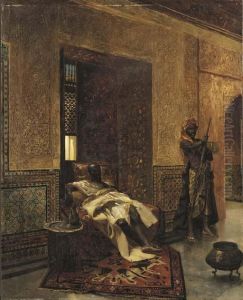Armande Benjamin-Constant Paintings
Jean-Joseph-Benjamin Constant, known more commonly as Benjamin-Constant, was a French painter and etcher best known for his Orientalist subjects and his work during the Belle Époque period. He was born on June 10, 1845, in Paris, France. His passion for exotic themes was largely influenced by the 19th-century European fascination with Oriental cultures, which was partly triggered by Napoleon's Egyptian campaign.
Benjamin-Constant studied at the École des Beaux-Arts in Toulouse and later in Paris under the tutelage of Alexandre Cabanel. He also became a close associate of the artist Jean-Léon Gérôme, another prominent French Orientalist painter. Benjamin-Constant's early works were mainly historical and mythological subjects, but after a trip to Morocco in 1872, he became captivated by North African and Middle Eastern themes.
He became well-known for his large-scale compositions that often depicted lavish interiors, Moorish architecture, and scenes of harems, which catered to the Western appetite for the exotic. His work was not only based on his travels but also on his imagination and Western stereotypes of Eastern culture. Beyond his Orientalist works, Benjamin-Constant also painted portraits of high society figures, including operatic stars and politicians, which added to his fame.
In addition to painting, he had a significant impact as a teacher, with his students including Henri Matisse and Edouard Vuillard. His teaching emphasized the importance of color in painting, which would be a significant influence on the development of Modernism.
Benjamin-Constant exhibited his work widely, including at the Paris Salon where he received several medals. He was also awarded the Legion of Honor in 1884. Despite his success, his work, like many Orientalist painters, would later be subject to criticism for its portrayal of Eastern cultures.
He died on May 26, 1902, in Paris, and his legacy is preserved in the collections of many major museums, including the Louvre in Paris and the Metropolitan Museum of Art in New York. His work is an important part of the Orientalist movement in European art, providing a rich historical record of Western perceptions of the East during the 19th century.
